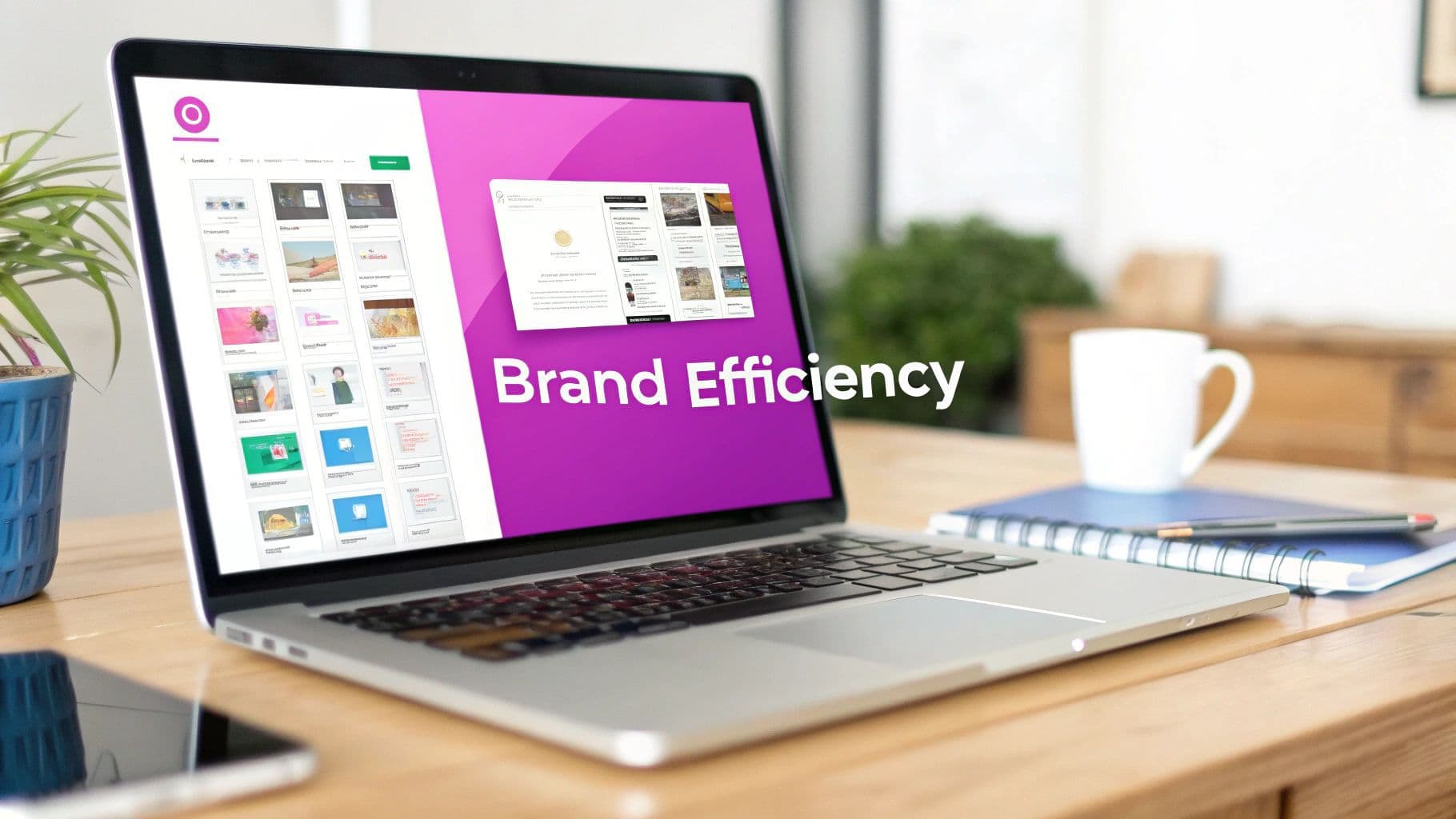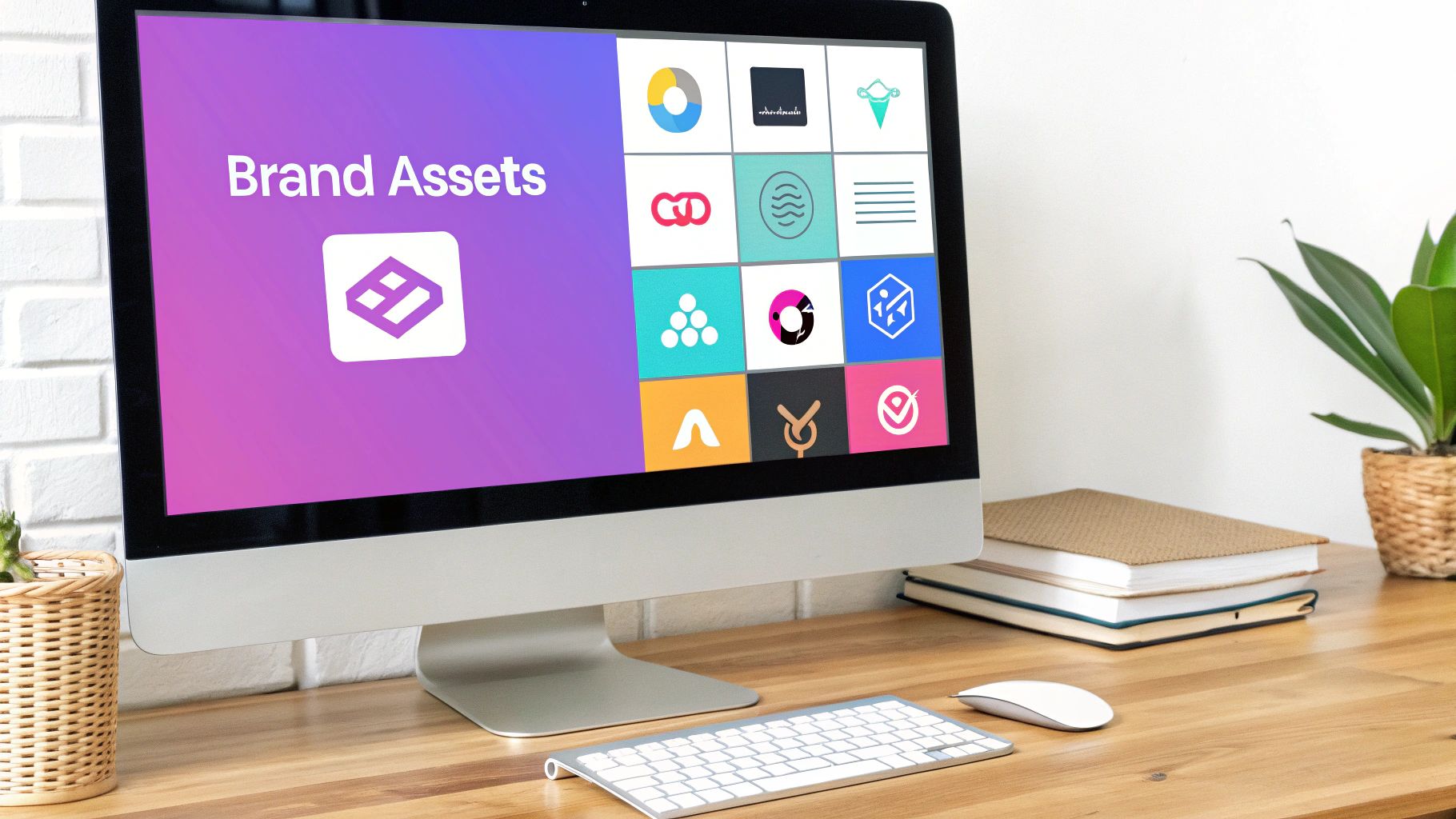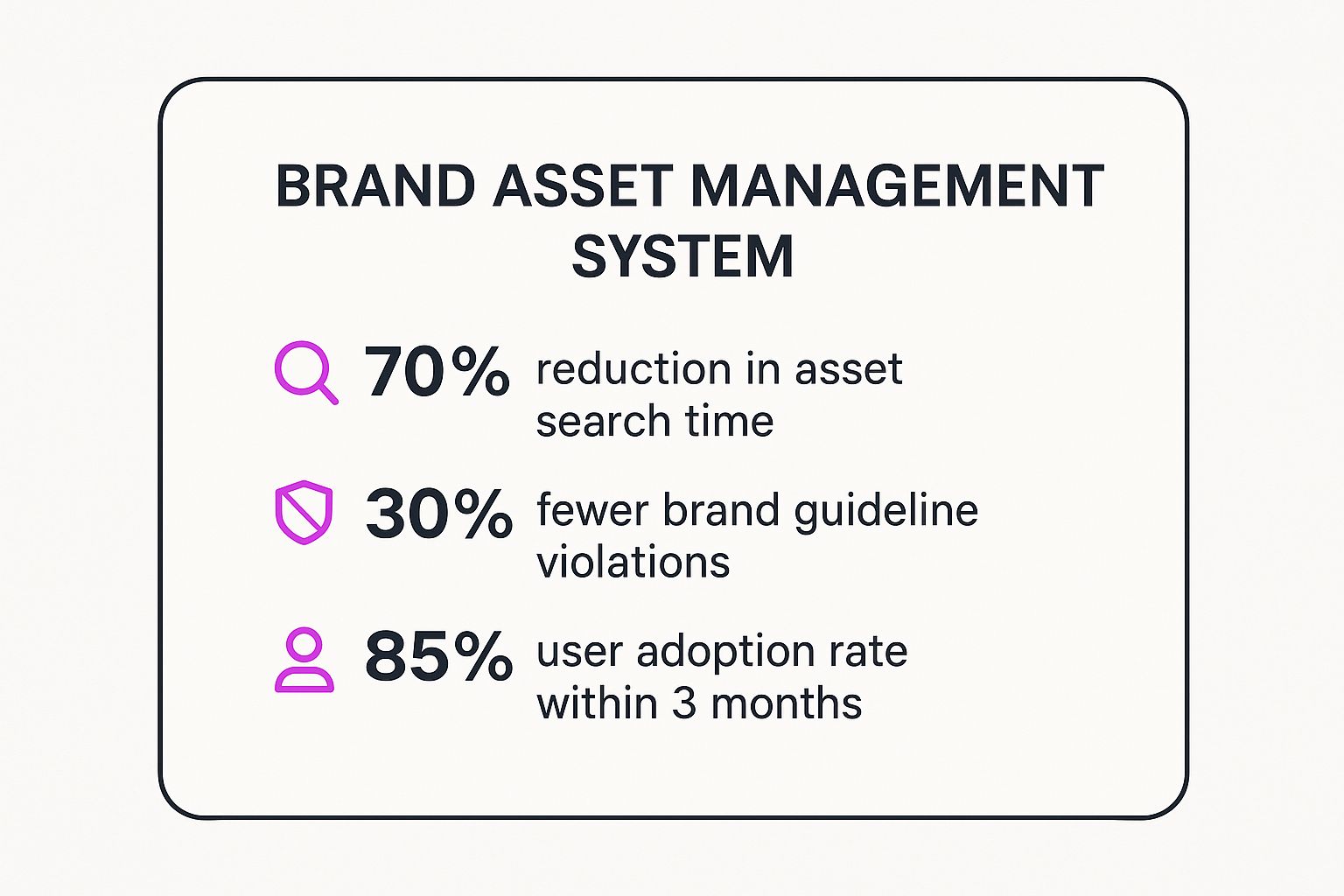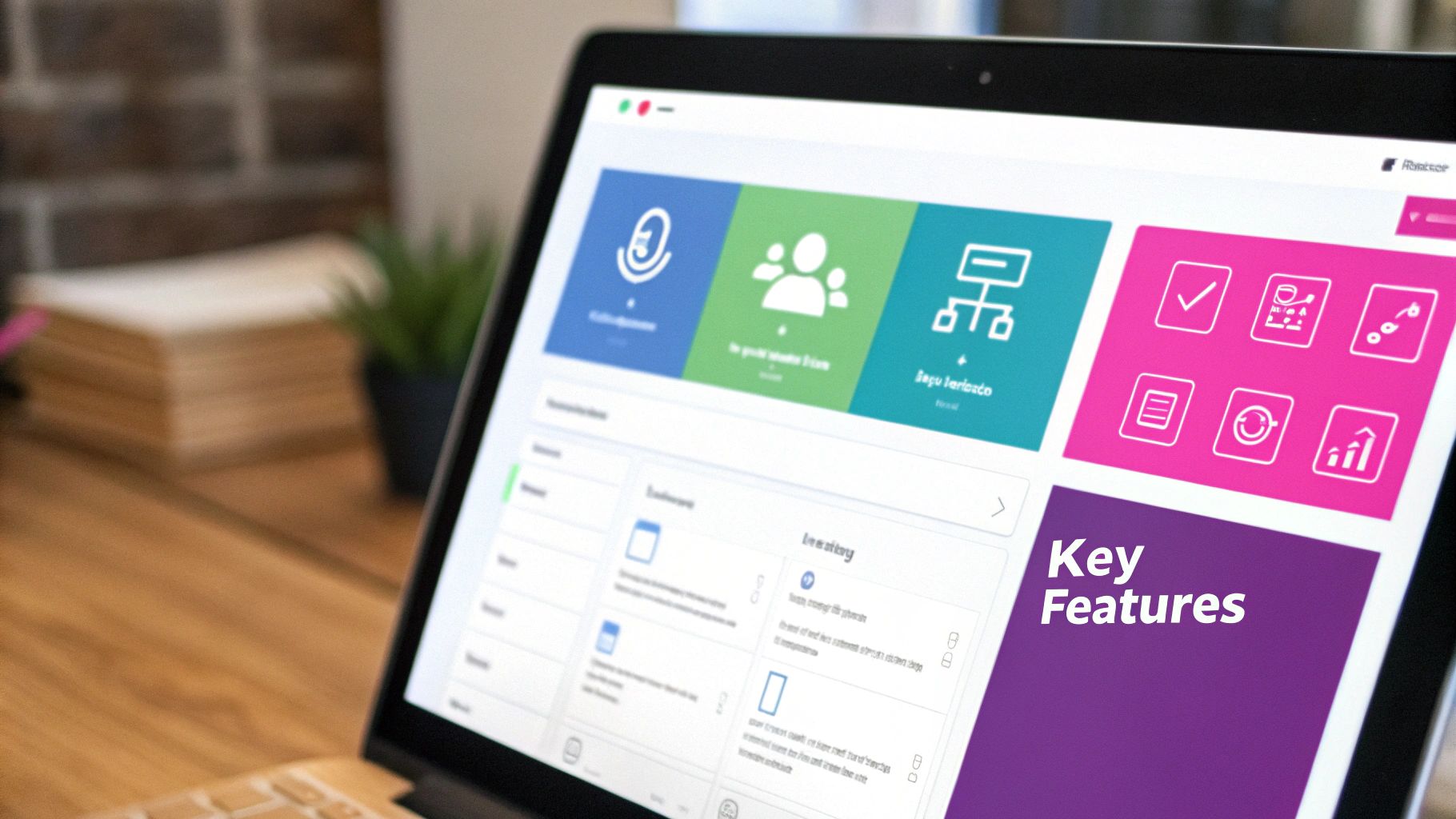
Boost Efficiency with a Brand Asset Management System

Aarav Mehta • October 8, 2025
Learn how a brand asset management system centralizes content and ensures consistency. Discover benefits and get started today!
A brand asset management system is your company's central library for every single digital brand material you own. Think of it as the master key that gives your team, partners, and agencies access to the right logos, images, and guidelines exactly when they need them.
Your Brand's Single Source of Truth

Picture your marketing department as a world-class orchestra. For the music to sound right, every musician—from the social media manager to the web designer—needs the official sheet music. A brand asset management system is the conductor, making sure everyone has the latest, approved version.
Without that central hub, things get messy. Fast. Crucial assets disappear into a black hole of scattered desktop folders, forgotten cloud drives, and endless email threads. This isn't just inefficient; it actively waters down your brand's power.
The Cost of Brand Inconsistency
What happens when your team can't find the official assets? They improvise. They might grab a low-res logo from a Google search or use an old color palette they found in a presentation from three years ago. These small slip-ups might seem minor, but they add up, creating a fractured and unprofessional experience for your customers.
A strong, consistent brand isn't just about looking good. It’s about being instantly recognizable and building long-term trust. Inconsistency is like a crack in that foundation, making your brand feel unreliable.
A solid brand asset management system fixes this by creating a "single source of truth." This guarantees that every piece of marketing you produce, from a simple tweet to a massive ad campaign, is perfectly on-brand.
Establishing Order with a Central Hub
At its core, this system is about bringing order to your creative chaos. Even if you're just starting, you can begin organizing your identity with a simple dedicated brand assets template to centralize your approved logos, colors, and fonts. This digital library ensures anyone representing your brand has the right tools for the job.
This simple act of organizing delivers some quick wins:
- Time Savings: Your teams can stop hunting for files and get back to doing creative, valuable work.
- Brand Protection: It shuts down the unauthorized or incorrect use of your most important brand assets.
- Smoother Collaboration: Internal teams and external partners can finally work together without friction.
Once you have everything in one place, you can even learn how to create your own imagery using a brand kit-based generator, locking in that consistency even further. In the end, a brand asset management system is the bedrock of a strong, consistent, and scalable brand.
Core Features Of A Brand Management Platform
Think of a standard cloud drive like Google Drive as a digital filing cabinet. It holds stuff, but that's about it. A brand asset management system, on the other hand, is more like an intelligent, automated library staffed by expert librarians. It’s built from the ground up with special features that turn a chaotic mess of files into a well-oiled machine for your brand.
These are the features that separate a simple storage folder from a true brand hub.
Metadata-Driven Search and Version Control
At its core, a brand platform is all about findability. Metadata-driven search is the star of the show here. Instead of trying to guess what obscure folder name a designer used three years ago, your team can search using simple, intuitive tags. Think "2024 product launch," "social media ad," or "horizontal logo." This smart tagging means finding the perfect asset takes seconds, not hours.
Another lifesaver is version control. When someone uploads a new file, the system automatically archives the old one. It’s a simple concept, but it's a brand-saver. This feature single-handedly prevents that old, cringey logo from accidentally ending up on a major marketing campaign.
Controlling Access And Ensuring Compliance
A brand asset management system also gives you granular control over who can see, use, and edit your brand materials. User permissions and access controls are absolutely essential for protecting your brand's integrity.
You can set up specific rules for different teams. For example:
- Marketing Team: Can upload, edit, and approve all new campaign materials.
- Sales Team: Can view and download approved presentation templates and brochures.
- External Agencies: Get access only to the specific project folders they need to do their job.
This tiered access stops unauthorized changes in their tracks and makes sure partners only use assets that have been officially signed off for their specific purpose.
The real power of a brand management platform lies in its ability to not just store assets, but to guide their usage. It actively helps people make the right choices, turning brand compliance from a chore into a seamless part of their workflow.
Many of these systems also have integrated brand guidelines. This means the rules for using your logos, fonts, and colors are built right into the platform. When someone downloads a logo, the "how-to-use" instructions pop up right alongside it, giving them instant context. To get a fuller picture of how to monitor your brand's health, this guide on brand tracking software is a fantastic resource, as these tools often work hand-in-hand.
This infographic breaks down how these features deliver real, measurable results for businesses.

The numbers don't lie. These features aren't just "nice-to-haves"; they dramatically boost efficiency and lock down brand compliance. And if your team is busy creating new assets like logos, check out our guide to the best AI logo generator tools to keep your style consistent from the very beginning.
So, Why Should You Actually Care About This?

Let's be real—adopting new software is a big decision, and the return on investment has to be crystal clear. A brand asset management system isn't just another shiny tool to add to your tech stack. It’s a strategic move that delivers tangible value across your entire company.
When you boil it down, the benefits really stand on three powerful pillars that directly impact your bottom line.
Unbreakable Brand Consistency
The most immediate win? You finally achieve unbreakable brand consistency. Imagine a world where every single employee, freelancer, and agency partner has instant access to the right logos, fonts, color palettes, and messaging. No more guessing.
This is how you build a unified front. It's that consistency that builds trust and recognition with your audience, making your brand instantly memorable.
Without a central source of truth, teams inevitably grab whatever is easiest—outdated logos, off-brand colors, you name it. A brand asset management system puts a stop to that chaos for good.
A Huge Boost in Operational Efficiency
Beyond just looking good, these platforms bring a massive productivity boost to your daily grind. Just think about the hours your creative and marketing teams burn hunting for files, fielding endless asset requests, or redoing work because someone used the wrong version. It’s a soul-crushing time sink.
A brand asset management system flips the script. It automates those manual, repetitive tasks and turns the frustrating file scavenger hunt into a smooth, efficient process. Suddenly, your most creative minds are free to focus on what they do best: driving growth.
And we're not the only ones who see it. The market for brand management software was valued at USD 261.05 million in 2023 and is projected to more than double. That kind of growth tells you this is becoming a must-have for modern businesses. You can dig into the numbers yourself in this detailed brand management software market analysis.
Fortified Brand Security
Finally, think of a brand asset management system as your brand’s own personal security guard. It protects your valuable intellectual property from being misused, whether by accident or on purpose. You get to set granular user permissions, giving you total control over who can access, download, or edit specific assets.
This is an absolute game-changer when you're working with outside partners or have teams scattered across the globe.
A brand asset management system gives you the power to control your brand's narrative. It ensures that only approved, on-brand materials are used to represent your company, protecting your reputation and minimizing legal risks.
This level of control stops the unauthorized use of your logos cold, makes sure you're complying with stock photo licenses, and keeps sensitive or embargoed materials under lock and key. In short, it protects your brand from the common vulnerabilities that lead to expensive mistakes and a damaged reputation.
Choosing the Right System for Your Organization
Picking the right brand asset management system is a lot like choosing an engine for a car. The one you go with will dictate your speed, efficiency, and how much you can grow down the road. Not all platforms are built the same, and the best choice is always the one that fits your company’s unique needs and goals.
Before you even think about jumping on demos and sales calls, the first real step is to look inward. Map out your current workflows, pinpoint the biggest bottlenecks holding your creative process back, and—most importantly—talk to the teams who will actually be using the software every day. This discovery phase is what helps you build a non-negotiable checklist of must-have features.
Key Factors to Evaluate
Once you have a solid handle on what you need, you can start looking at vendors. As you size them up, focus on these critical areas. You're not just solving today's headaches; you're investing in your future ambitions.
- Scalability: Can this thing grow with you? Don't just think about how many assets you have today. Think about how many you’ll have in two years, or five. The platform has to handle an exploding library and a bigger team without slowing to a crawl.
- Integration Capabilities: A brand asset management system can't be a lonely island. It needs to play nice with the other tools in your marketing stack, like your CMS, design software, and project management hubs. Smooth integrations are the secret to a frictionless workflow and a massive efficiency boost.
- User Interface (UI) and Experience (UX): Let's be honest—if the system is a clunky, confusing mess, your team just won’t use it. An intuitive, clean interface is absolutely essential if you want people to actually adopt it. The goal is to make finding, sharing, and managing assets feel totally effortless.
Your brand asset management system should be a tool that empowers creativity, not a hurdle that slows it down. The right platform will feel like a natural extension of your team’s workflow, making brand compliance the easiest possible choice.
Kicking off your research with a comparison grid from a software review site can be a really helpful starting point.
This kind of overview gives you a quick, at-a-glance look at features, user satisfaction ratings, and the market presence of the top players.
Finding the Perfect Fit
Ultimately, the mission is to find a system that lines up perfectly with how you operate and what you can spend. Beyond the core features, don’t forget to look at the level of customer support they offer and the pricing models available—whether it's per-user, based on storage, or something else.
As you weigh your options, keep in mind that many modern marketing tools are getting smarter with AI. To get a better sense of where things are headed, check out our guide on the top AI marketing software and see how automation is changing the entire game. By building a detailed checklist based on all these factors, you can confidently pick a system that will become a powerful foundation for your brand’s success for years to come.
Implementing Your New Brand Hub

So, you’ve picked out your brand asset management system. Now for the real work. Rolling out a new brand hub is more than just flipping a switch on some new software—it’s about fundamentally changing how your entire team works with brand assets. Get it right, and it becomes the beating heart of your brand. Get it wrong, and it’s just another tool nobody uses.
The first step is a bit of digital archaeology. You have to know what you’ve got before you can organize it. This means a full-blown audit of every brand asset, digging through scattered desktops, forgotten shared drives, and endless email threads to find all those hidden files.
Building a Logical Foundation
Once you've rounded up all your assets, it's time to build a framework that actually makes sense to a human being. Start with a logical folder hierarchy, but the real magic is in your metadata strategy. Think of metadata as the secret sauce that makes your assets instantly findable.
A solid metadata plan should let you tag and filter by things like:
- Asset Type: Is it a logo, product photo, case study, or video?
- Campaign: "Q4 Holiday Sale" or "Summer 2024 Launch."
- Usage Rights: Can it be used anywhere, or is it for internal eyes only? Does it expire?
- Product Line: Which specific product or service does this asset promote?
This is the groundwork that turns a messy digital closet into a powerful, searchable brand asset management system.
The goal of implementation isn't just to store files—it's to change behaviors. Success is measured by how easily your team can find what they need and how confidently they can use it, knowing it's the correct, on-brand version.
With the structure in place, the next crucial step is setting up user roles and permissions. This is your brand’s security detail. It ensures the right people have the right level of access, protecting your brand from accidental mishaps. Your design team might get upload and editing rights, while the sales team gets download-only access to the final, approved presentations. No more rogue edits.
Driving Adoption Through Training
Finally, don't forget the human element. The most brilliant system in the world is useless if nobody knows how to use it—or worse, doesn't want to. A solid training plan isn't optional; it's essential for getting your team on board.
Create clear guides, run a few live training sessions, and spend time showing each department what's in it for them. Show the sales team how they can find the latest deck in seconds. Show marketing how they can stop answering "where's the logo?" emails. When your team sees the new hub as a tool that makes their lives easier, you’ve won.
Best Practices for Long-Term Success
Getting a brand asset management system up and running is a great first step, but the real magic happens over time. This isn’t a crockpot you can just set and forget. Think of it more like a living library—it needs a good curator to keep it from turning into a chaotic mess.
To make sure your system actually stays useful, you need to anoint a dedicated ‘brand librarian.’ This might be one person or a small team, but their job is critical. They own the platform’s health, keep it organized, and make sure every single asset is exactly where it’s supposed to be. They’re the go-to expert.
Maintaining a Clean and Current Library
Just like a real library weeds out old, dusty books, your brand hub needs regular clean-ups. Put it on the calendar—a quarterly or bi-annual audit to find and archive anything that’s outdated. This one simple habit can save you from the nightmare of someone accidentally using last year's campaign logo on a new project.
A clear governance policy is also a must-have. These are the house rules that keep everything humming along smoothly. Your policy should spell out:
- Uploading Protocols: Who has the keys? Decide who is actually allowed to add new assets.
- Tagging Standards: What’s the secret sauce for making files findable? Define the metadata every new file needs.
- Usage Rights: Are there any licensing time-bombs or expiration dates? Document them clearly so everyone stays compliant.
Making these rules stick ensures every new asset adds value instead of just clutter.
The long-term value of your brand asset management system comes from a constant cycle of improvement. It should grow with your brand, not become a digital time capsule of campaigns from five years ago.
Finally, you have to talk to your users. Actively ask your teams what’s working, what’s driving them crazy, and what features would make their lives easier. This feedback is gold. It tells you exactly where to focus your efforts and helps the platform adapt as your brand’s needs change.
Staying proactive is crucial, especially since the brand management market is expected to hit USD 1,422.70 million by 2032. That growth is all about the increasing pressure for brands to be consistent in a ridiculously crowded digital world. You can dig into more stats on the growth of the brand management software market if you’re curious.
Common Questions About Brand Asset Management
Even after seeing all the benefits, it’s natural to have a few questions before jumping into a brand asset management system. Let's clear up some of the most common ones to help you figure out its role and set the right expectations.
Most people are trying to understand how this tool is any different from the cloud storage they already use, and if it’s even right for their company’s size. Let’s tackle those head-on.
What Is the Difference Between DAM and BAM?
This one comes up all the time. While they sound almost identical, the real difference is focus. A Digital Asset Management (DAM) system is the big, all-encompassing tool designed to store, sort, and manage any digital file your company owns—think legal documents, raw video files, internal presentations, you name it. It's like the entire company's digital filing cabinet.
A Brand Asset Management (BAM) system, on the other hand, is a specialized sub-category of DAM. It zeroes in specifically on the assets that shape your brand identity. It’s built from the ground up to manage and enforce the consistent use of logos, official marketing templates, brand guidelines, and approved campaign photos.
Think of it this way: a DAM is the entire library, holding every book on every subject. A BAM is the curated "Featured New Releases" shelf right at the front, holding only your brand's most important, ready-to-use stories.
How Can a Small Business Benefit?
A brand asset management system is a secret weapon for small businesses because it builds a rock-solid foundation for growth. It helps lock in brand consistency right from the start, preventing the messy, off-brand visuals that inevitably happen when a team starts to grow quickly.
For a small team, the wins are immediate and tangible:
- It saves a ton of time. No more "Hey, can you send me the latest logo?" emails. Everyone can find what they need, right when they need it.
- It professionalizes your marketing. Freelancers, new hires, and partners can get up to speed on your brand standards instantly, ensuring everything they create looks like it came from you.
- It builds a foundation that scales. You’re creating an organized, single source of truth that grows with the company, not against it.
What Is the Hardest Part of Implementation?
The biggest hurdles are usually a mix of technical grunt work and human nature.
On the technical side, the initial lift can be pretty big. Auditing, gathering, and correctly tagging thousands of assets scattered across desktops, Dropbox folders, and old hard drives is a serious project. It takes a focused effort to wrangle everything into one organized place.
But the human side is often the real challenge: getting people to actually use it. If you don't provide good training and clearly show how the new system makes everyone's job easier, people will slip back into their old habits of saving files to their desktops. A well-thought-out launch with plenty of training is absolutely critical for it to stick.
Ready to create stunning, on-brand visuals without the hassle? Bulk Image Generation uses advanced AI to produce hundreds of unique images in seconds. Describe your vision, and let our platform handle the rest, from style to composition. Start creating professional images with Bulk Image Generation today!